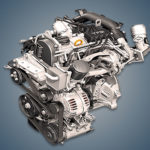The 1.6-liter 16-valve Volkswagen CWVB 1.6 MPI 90 hp engine has been assembled since 2015 and put on such popular budget models as the Rapid or Polo Sedan. This motor differs from its 110-horsepower counterpart with the CWVA index only in firmware.
The EA211 series includes: CWVA, CWVB, CJZA, CJZB, CHPA, CMBA, CXSA, CZCA, CZDA, CZEA, DJKA, DACA, DADA.
Specifications
| Production years | since 2015 |
| Displacement, cc | 1598 |
| Fuel system | injector |
| Power output, hp | 90 |
| Torque output, Nm | 155 |
| Cylinder block | aluminum R4 |
| Block head | aluminum 16v |
| Cylinder bore, mm | 76.5 |
| Piston stroke, mm | 86.9 |
| Compression ratio | 10.5 |
| Features | DOHC |
| Hydraulic lifters | yes |
| Timing drive | belt |
| Phase regulator | on the intake shaft |
| Turbocharging | no |
| Recommended engine oil | 5W-30 |
| Engine oil capacity, liter | 3.6 |
| Fuel type | petrol |
| Euro standards | EURO 5 |
| Fuel consumption, L/100 km (for VW Polo Sedan 2018) — city — highway — combined |
7.8 4.6 5.8 |
| Engine lifespan, km | ~300 000 |
The engine was installed on:
- Skoda Rapid 1 (NH) in 2015 – 2020; Rapid 2 (NK) since 2019;
- Volkswagen Polo Sedan 1 (6C) in 2015 – 2020;
- Volkswagen Polo Liftback 1 (CK) since 2020;
- Volkswagen Jetta 6 (1B) in 2016 – 2019.
Disadvantages of the VW CWVB engine
- Most often, car owners with this engine complain about high lubricant consumption;
- An oil level sensor is not provided here, so such motors often wedge;
- The camshaft oil seals are regularly squeezed out and the lubricant gets on the timing belt;
- Plastic pump with two thermostats does not last long, and replacement is expensive;
- Due to the design of the exhaust system, the engine is prone to vibrations in winter.






